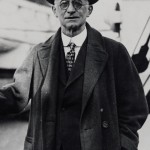Weekly Wrap Volume 58
The smell comes from the way certain chemical compounds in asparagus break down inside people’s bodies. This is why cooking asparagus in various ways does not result in the same smelly byproduct; the specific digestive enzymes that break down the compounds in the asparagus to produce the smell aren’t present until you eat the asparagus. As to this specific resulting chemical compound that ends up causing the smell, it has long been thought… (more)
 Origins of the Jedi (and Other Star Wars Stuff)
Origins of the Jedi (and Other Star Wars Stuff)
No one can dispute George Lucas’ significant contributions to cinema history, including both the Star Wars and Indiana Jones franchises. His company also played a role in advancing special effects, top quality post-production audio and even digital sound systems for movie theaters. But it is nice to know that he didn’t invent everything out of whole cloth; when developing the Star Wars movies, he was hugely influenced from the work of Japanese director Akira Kurosawa, among others. A titan of Japanese cinema, Kurosawa was heavily… (more)
 15 Fascinating Cell Phone Related Facts You Probably Didn’t Know
15 Fascinating Cell Phone Related Facts You Probably Didn’t Know
1) The Name: “Cellular phones,” or more common today “cell phones,” get their name from the fact that areas served by towers are divided up into “cells.” The first use of the word “cellular” in this fashion was in 1977. The first documented use of the word “cell phone” was in 1984. 2) The First: On April 3, 1973, a Motorola employee, Martin Cooper, publicly demonstrated the world’s first handheld mobile phone by placing a call to Joel Engel, the head of research at AT&T’s Bell… (more)
 Is There Any Difference at all Between Men’s and Women’s Razors and Shaving Creams?
Is There Any Difference at all Between Men’s and Women’s Razors and Shaving Creams?
Shaving companies almost universally put out both a men’s and women’s version of each of their products, with the women’s version generally costing quite a bit more. But is there actually any difference between the so-called “gendered razors” and shaving cream or is it all just clever marketing? We’ll start with whether there is any difference in the razors. The answer to this question largely depends on what exactly you are referring to when you say “razor”. If we’re exclusively talking about the razor blades themselves, then there is… (more)
 The Timely Death of Kodak Founder George Eastman
The Timely Death of Kodak Founder George Eastman
It was March 14, 1932 when George Eastman, famed inventor, philanthropist, and founder of Eastman Kodak, invited a few loyal friends over to witness the rewriting of his will. He had made the decision to give a good portion of his money and prized possessions, including his enormous mansion, to the city he called home for his whole life- Rochester. To this end, he bequeathed his house and a $2 million endowment (about $34 million today) to the University of Rochester. Eastman also donated a large sum of money to dental dispensaries across the city, attempting to ensure that no child in Rochester would go without proper dental work. Finally, he left $200,000 (about $3.4 million today) to his beloved niece, Ellen. Cheerfully signing the will, he assured his friends this was just a matter of ensuring his wishes. Later, it was thought that he also wanted his… (more)
Bonus Quick Facts:
- The most peeps ever eaten by one person in a half an hour is 102, done by Dennis Gross in 2003.
- Common foods that are naturally radioactive include potatoes, bananas, sunflower seeds, Brazil nuts, and kidney beans, among others. Brazil nuts are the most radioactive by far at 6600 picocuries per kg or about 1.875 BED (banana equivalent dose). The radium in Brazil nuts does not come from especially high levels of radium in the soil where the trees grow, but rather the very extensive root systems the trees develop, which cover a much larger area of the soil than most trees.
- Although bananas and Brazil nuts contain very little ionizing radiation, in terms of what might actually harm a human, they are radioactive enough to trigger false alarms in some radiation sensors used to detect illegal smuggling of nuclear materials.
- Komodo dragons, hammerhead sharks, Brahminy blind snakes, water fleas, certain types of bees, scorpions, wasps, and even some types of birds, among others, are capable of reproducing asexually, if necessary.
- The tallest man in history was Robert Pershing Wadlow, who was 8 feet 11.1 inches (2.72 m) tall and 485 pounds at the time of his death. By the age of 4 years old, he was already 5 ft 4 inches tall (1.63m). At the age of 13, he became the tallest boy scout in history at 7 ft 4 inches (2.24m). Wadlow had not yet stopped growing at the time of his death at the age of 22. He died in 1940 of an infection caused from blisters on his ankle that he didn’t notice at first due to not being able to feel much of anything in his feet and lower legs.
- Katy Perry’s real name is Katheryn Elizabeth Hudson, but she created the stage name “Katy Perry” so as not to be confused with Kate Hudson. Before she did this, she did release an album under her real name, with the album called “Katy Hudson”. The album flopped. It wasn’t until she signed with Capitol Music Group in 2007 that she adopted the stage name Katy Perry.
- “Hangover” was a common term in the 19th century meaning “unfinished business”. Around the early 20th century, the common meaning shifted slightly to mean as it does today.
- Ben & Jerry got their start making ice cream after taking a $5 course on ice cream making at Penn State. Originally they were going to make bagels, but decided the cost of the setup was too much.
- “Head,” describing a toilet, was originally a maritime euphemism. This came from the fact that, classically, the toilet on a marine vessel was located at the front of the ship (the head). This was so that water from the sea that splashed up on the front of the boat would wash the waste away. This term is thought to have been used as early as the 17th century. The first known documented occurrence of the term, however, was from 1708 by Woodes Rogers, Governor of the Bahamas; he used the word to refer to a ship’s toilet in the book “Cruising Voyage Around the World.”
- During Prohibition, Grape growers of the day began selling “bricks of wine,” which were primarily blocks of “Rhine Wine.” These often included the following instructions: “After dissolving the brick in a gallon of water, do not place the liquid in a jug away in the cupboard for twenty days, because then it would turn into wine.”
- “Play it again, Sam” was never said in Casablanca. Furthermore, although many attribute the adapted version to Bogart, the closest thing to it comes from Bergman’s character, Ilsa, who says, “Play it once Sam… for old time’s sake…. Play it, Sam. Play, ‘As Time Goes By’.”
Other Interesting Stuff:
 Why Does Moist, Baled and Stacked Hay Spontaneously Catch Fire?
Why Does Moist, Baled and Stacked Hay Spontaneously Catch Fire?
Plant reactions and bacterial growth combine to raise temperatures in even the driest hay bales, although most never catch fire on their own. However, when hay is packed tightly, and enough moisture gets in, the conditions may be right for spontaneous hay combustion. How does this work? Bacteria thrive when sufficient glucose (a simple sugar found in plants) is available. In the process of breaking it down into energy, aerobic bacteria catabolize the glucose, turning it into a usable form. Through the process of respiration, these bacteria completely oxidize the glucose – transforming it into carbon dioxide, water and energy. This last is released as heat. Likewise, even after it’s cut, the cells in the hay plant itself are still active, also respiring, and in a similar process to the bacteria, converting glucose… (more)
 Why Do We Say Costs Can Be “Footed” by Someone?
Why Do We Say Costs Can Be “Footed” by Someone?
Turning a noun into a verb and then employing it in a way that seems completely out of context, the phrase “foot the bill” has long been used to mean paying the cost of something (that usually benefits more than one person). The first written record of the phrase appears in 1819 in Estwick Evans Pedestrious Tour of Four Thousand Miles where the intrepid Evans (he took off on a walking tour of the Michigan Territory in the middle of winter) noted… (more)
 Why Do American Footballers Say “Hut, Hut, Hike!”
Why Do American Footballers Say “Hut, Hut, Hike!”
An integral part of the game, immediately prior to the start of play, the football quarterback begins his cadence. More than just “hut,” the offensive leader on the field uses short commands to prepare the team, adjust to the defense’s line up and even change the play. Whether it’s “53 is the Mike,” “Omaha,” “Red 32,” “Set” or “Hike,” each shout is an important tool in the quarterback’s bag of tricks. The most well known cadence, “hike,” was the brainchild of John Heisman (of the eponymous trophy). Prior to its introduction, commonly the quarterback signaled the center to give him the ball by simply scratching the center’s leg. During the 1890-1891 season, Heisman was playing center for the University of Pennsylvania when a leg scratch from an opposing player tricked into hiking early. To fix the problem, Heisman introduced using a word to start the snap… (more)
 Jus Primae Noctis: Fact or Fiction?
Jus Primae Noctis: Fact or Fiction?
The practice of jus primae noctis (“right of the first night”) is, in simplest terms, the right of the local noble to deflower local peasant brides on their wedding night before their newlywed husbands. Precedence for this practice supposedly goes back for many thousands of years, with the first reference of something like it going all the way back to the Epic of Gilgamesh from over four thousand years ago. This practiced (apparently) reached its crescendo during the Middle Ages in Europe, and today is popularly depicted in Hollywood in such films as Braveheart. But did it really ever happen? Numerous historians have studied the subject and the result is that it turns out there is… (more)
This Week’s Podcast Episodes:
- Podcast Episode #240: The Real Moby Dick
- Podcast Episode #241: The Mushroom Cloud
- Podcast Episode #242: The Truth About Who Invented the Fortune Cookie
- Podcast Episode #243: Living Without a Head
- Podcast Episode #244: The Gruesome Tale of Lady Bluebeard
Quote of the Week:
- “Any fool can know. The point is to understand.” – George Finlay
| Share the Knowledge! |
|





